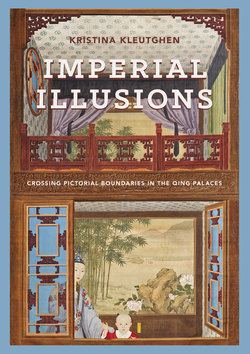Читать книгу Imperial Illusions - Kristina Kleutghen - Страница 64
На сайте Литреса книга снята с продажи.
Оглавлениеas the Qianlong emperor in 1736, the established relationship between ruler and painter deepened into favored patronage for the Italian. Castiglione, a respected master court painter specializing in portraiture, served Qianlong faithfully as a painter, painting teacher, and architect until his death in 1766, when Qianlong buried the Italian in Beijing and posthumously promoted him to vice-minister (shilang). This unprecedentedly high rank for a foreigner demonstrated the ruler’s esteem and personal affection for both the man and his artistic talents that served three High Qing emperors over more than fifty years.
Although Castiglione was unquestionably a significant influence on Qing court painting, and almost certainly the most talented European artist to serve these emperors, he has rather overshadowed the five European colleagues and the many Chinese colleagues with whom he served in Qianlong’s Wish-Fulfilling Studio. Perhaps the best known after Castiglione is the French Jesuit Jean-Denis Attiret (Wang Zhicheng, 1702–68), who arrived in 1737 and whose numerous letters back to French colleagues were published in the Lettres édifiantes et curieuses, most importantly his 1742 letter describing the Perfect Brightness Garden.95 The other four artists are much less known. The Bohemian Jesuit Ignatius Sichelbarth (Ai Qimeng, 1708–80) arrived in 1745 and is best known for his paintings of dogs; the Italian Augustine Giovanni Damasceno Salusti (An Deyi, d. 1781) is also best known for paintings of dogs. The Italian Jesuit Giuseppe Panzi (Pan Tingzhang, d. before 1812) and the French Jesuit Louis de Poirot (He Qingtai, 1735–1813) both arrived in 1771, several years after Castiglione’s death.96 Regardless of when they arrived at court, these men worked side by side with their non-European colleagues, such as Yao Wenhan (act. 1743–c. 1773), Jin Tingbiao (act. mid-eighteenth century), Ding Guanpeng (c. 1708–71), Shen Yuan (act. mid-eighteenth century), and Castiglione’s students, including Zhang Weibang (act. c. 1726–61), Wang Youxue (act. c. 1733–80s), Wang Ruxue (act. mid–late eighteenth century), and the Manchu Ilantai (act. c. 1750s–90s).97
Qianlong maintained an active role in his painting academy, particularly the elite branch of the Wish-Fulfilling Studio, and was familiar enough with each man’s particular talents to request specific artists for particular projects. Typically, he would first commission one or more artists to produce a draft of a painting intended for a specific location and later comment personally on that draft, often requesting changes before finally approving it for execution and ultimately approving the finished work.98 Following standard practice, the men of the Wish-Fulfilling Studio frequently collaborated on commissions, each contributing his individual talents in painting faces, robes, architecture, landscape, flowers, and so on to create the “best” overall work (although not necessarily the most stylistically cohesive). Often their extant works are unsigned: rarely do the many collaborative works in the Qing imperial collection display the names of the many hands involved in them, but sometimes attributions can be established from the painting academy archives. These archives also reveal that many works signed only by Castiglione were in fact produced by several artists. Careful consideration, therefore, should be given to any painting attributed solely to him.99
